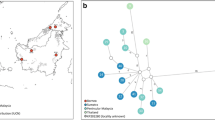Abstract
Molecular techniques are gaining importance in biodiversity conservation in India. They are especially beneficial in the case of rare species with cryptic habits that make them difficult study subjects when using conventional field techniques. Molecular tools can be used to decipher distributions and population connectedness in fragmented habitats and identify populations of immediate conservation concern. We discuss these with case studies on some cat species in India.
Similar content being viewed by others
Suggested Reading
N J Abram, H V McGregor, J E Tierney, M N Evans, N P McKay, D S Kaufman and PAGES 2k. Consortium, Early Onset of Industrial-era Warming Across the Oceans and Continents, Nature, Vol.536, pp.411–418, doi:10.1038/nature19082, 2016.
G Ceballos, P R Ehrlich and R Dirzo, Biological Annihilation Via the Ongoing Sixth Mass Extinction Signaled by Vertebrate Population Losses and Declines, Proceedings of the National Academy of Sciences, USA 114:E6089âĂŞE6096, 2017.
G E Collier and S J O’Brien, A Molecular Phylogeny of the Felidae, Evolution, Vol.39, pp.473–487, 1985.
W E Johnson and S J O’Brien, Phylogenetic Reconstruction of the Felidae Using 16s rRNA and NADH-5 mitochondrial genes, Journal of Molecular Evolution, 44(Suppl 1): pp.S98–S116, 1997.
A Kitchener, C Breitenmoser, E Eizirik, A Gentry, L Werdelin, A Wilting, N Yamaguchi, A Abramov, P Christiansen, C Driscoll, W Duckworth, W Johnson, S J Luo, E Meijaard, P O’Donoghue, J Sanderson, K Seymour, M Bruford, C Groves, S Tobe, A Revised Taxonomy of the Felidae, The Final Report of the Cat Classiication Task Force of the IUCN/SSC Cat Specialist Group, Cat News Special Issue, 2017.
L Werdelin, N Yamaguchi, W E Johnson, S J O’Brien, Phylogeny and Evolution of Cats (Felidae), In Biology and Conservation of Wild Fields (eds Macdonald DW, Loveridge AJ), pp.59–82, Oxford, UK: Oxford University, 2010.
S Mukherjee, A Krishnan, K Tamma, C Home, R Navya, S Joseph, A Das and U Ramakrishnan, Ecology Driving Genetic Variation: A Comparative Phylogegraphy of Jungle Cat (Felis chaus) and leopard cat (Prionailurus bengalensis) Populations in India, PLoS ONE, 5(10): e13724. doi:10.1371/journal.pone.0013724, 2010a.
M Sunquist and F Sunquist, Wild Cats of the World, Chicago: University of Chicago Press, p.452, 2002.
J Sanderson, S Sunarto, A Wilting, C Driscoll, R Lorica, J Ross, A Hearn, S Mukherjee, J A Khan, B Habib and L Grassman, Prionailurus bengalensis, The IUCN Red List of Threatened Species 2008: e.T18146A7671433, 2008. http://dx.doi.org/10.2305/IUCN.UK.2008.RLTS.T18146A7671433.en
R I Pocock, The Fauna of British India, Including Ceylon and Burma, Mammalia 1: Primates and Carnivora, (In part), 2nd edn., (Reprint edition, 1985 New Delhi: Today and Tomorrow’s Printers and Publishers) Chicago: University of Chicago Press. 463 p, 1939.
J Ross, J Brodie, S Cheyne, A Hearn, M Izawa, B Loken, A Lynam, J Mc-Carthy, S Mukherjee, C Phan, A Rasphone and A Wilting, Prionailurus bengalensis, The IUCN Red List of Threatened Species, e.T18146A50661611, 2015. http://dx.doi.org/10.2305/IUCN.UK.2015-4.RLTS.T18146A50661611.en.
S Mondol, K U Karanth and U Ramakrishnan, Why the Indian Subcontinent Holds the Key to Global Tiger Recovery, PLoS Genetics, 5(8): e1000603, 2009.
S J Luo, J H Kim, W E Johnson, JVD Walt, J Martenson, et al., Phylogeography and Genetic Ancestry of Tigers (Panthera tigris), PLoS Biol, Vol.2, p.e442, 2004.
S Mondol, M W Bruford and U Ramakrishnan, Demographic Loss, Genetic Structure and the Conservation Implications for Indian Tigers, Proceedings of the Royal Society B: Biological Sciences, Vol.280, p.1762, 2013.
M Natesh, G Atla, P Nigam, Y V Jhala, A Zachariah, A P Reddy, U Borthakur and U Ramakrishnan, Conservation Priorities for Endangered Indian Tigers Through a Genomic Lens, Scientiic Reports, 7 (1), 9614, 2017.
A Joshi, S Vaidyanathan, S Mondol, A Edgaonkar and U Ramakrishnan, Connectivity of Tiger (Panthera tigris) Populations in the Human-Influenced Forest Mosaic of Central India, PLoS ONE, 8(11): e77980, https://doi.org/10.1371/journal.pone.0077980, 2013.
P Thatte, A Joshi, S Vaidyanathan, E Landguth and U Ramakrishnan, Maintaining Tiger Connectivity and Minimizing Extinction into the Next Century: Insights from Landscape Genetics and Spatially-explicit Simulations, Biological Conservation, Vol.218, pp.181–191, 2018.
T C Trigo, T R O Freitas, G Kunzler, L Cardoso, J C R Silva, W E Johnson, S J O’Brien, S L Bonatto and E Eizirik, Inter-species Hybridization Among Neotropical Cats of the Genus Leopardus and Evidence for an Introgressive Hybrid Zone Between L. geoffroyi and L. tigrinus in Southern Brazil, Molecular Ecology, Vol.17, pp.4317–4333, 2008.
T C Trigo, A Schneider, T G de Oliveira, L M Lehugeur, L Silveira, T R O Freitas and E Eizirik, Molecular Data Reveal Complex Hybridization and a Cryptic Species of Neotropical Wild Cat, Current Biology, Vol.23, pp.2528–2533, 2013.
Author information
Authors and Affiliations
Corresponding authors
Additional information
Shomita is a Principal Scientist at the Sálim Ali Centre for Ornithology and Natural History, Coimbatore. She is interested in all aspects of small cat ecology and evolution as well as exploring limits to geographical distributions of species (other than cats too).
Uma is an associate professor at the National Centre for Biological Sciences, TIFR. She is interested in applying genetic methods to the conservation of endangered species.
Rights and permissions
About this article
Cite this article
Mukherjee, S., Ramakrishnan, U. Molecular Tools For Biodiversity Conservation. Reson 23, 309–324 (2018). https://doi.org/10.1007/s12045-018-0620-4
Published:
Issue Date:
DOI: https://doi.org/10.1007/s12045-018-0620-4




